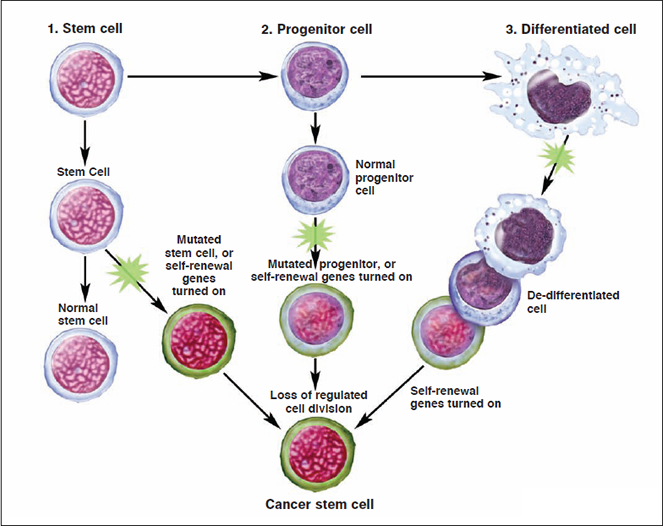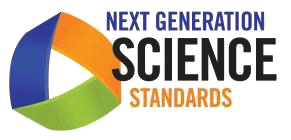Advanced: Stem Cell Differentiation and the Cancer Stem Cell Hypothesis
Overview
Students will learn about stem cell differentiation into lineages, creating multiple cell types that together contribute to the function and maintenance of organs and body systems. This lesson addresses the Next Generation Science Standards (NGSS) Performance Expectation HS-LS1-4. View the standards that apply to this unit.
As a class, students construct a simplified blood cell lineage “tree” and then individually research disorders caused by abnormal immune cells. The original pool of blood stem cells and therefore the entire blood lineage is maintained by a specialized type of mitosis called asymmetric cell division. Discussion then focuses on cancer and how mutations can lead to the transformation of a normal cell into a cancer cell. In breast cancer, stem cells or progenitor cells are the source of the transformation. Students can watch narrated animations to learn about the breast as an organ, the environment’s influence on stem cells that maintain milk-producing ducts, and how mutations in breast progenitor cells lead to breast cancer. Students will learn to distinguish stem cells from progenitor cells and that the microenvironment not only controls cell behavior but also transformation into a cancer stem cell.
Important Terminology
Microenvironment: the local surroundings of a cell that feed into its behavior.
Students can think of the microenvironment as the dorm in which a stem cell lives and functions. The microenvironment has non-living materials (concrete, rebar, furniture), other cells (roommates, neighbors, and visitors), as well as signaling molecules (voices, visuals, objects in the way) that help our stem cell character navigate in the world and decide what to do. For cells, even forces (sensed as physical variations in the extracellular matrix) can influence cell fate.
The specific microenvironment of stem cells is called the stem cell niche. This environment influences the development of stem cells from quiescence through stages of differentiation. Just like the ecological niche of an organism, a stem cell niche is unique to the individual or small population and guides its dynamics. The four major components of the microenvironment are soluble factors, cell-cell interactions, extra-cellular matrix proteins, and forces.
Soluble factors: Received from the extracellular environment, soluble factors typically bind a cell’s plasma membrane or cytoplasmic receptors. While soluble factors, such as proteins, hormones, and cytokines, vary in biochemical composition and origin, their signaling outcomes can be classified into four main cell behaviors:
- Survival: typically achieved through suppressing apoptosis.
- Division: promotes synthesis of proteins and inhibits their degradation.
- Differentiation: cell specialization occurs through changes in metabolism, gene expression, and cell shape/migration.
- Death: in most cases, an intracellular proteolytic pathway is activated and the bulk of the work performed by a certain class of proteins called caspases.
Cell-cell interactions: Cells can also receive extracellular signals from connections made with their neighbors. These connections can vary in size, composition, strength, and cargo transported.Normal cells grown in a petri dish will divide until they completely cover the surface, when they experience contact inhibition and stop dividing. But cancer cells lose this contact inhibition, suggested by the observation that they continue growing on top of each other after they cover the whole petri dish. Cancer cells do not respond normally to growth regulatory signals induced by cell-cell interactions.
Extracellular matrix proteins: These proteins make up the scaffold within which cells adhere and grow. This scaffold, called the extracellular matrix, is made of collagen, fibronectin, laminin, and other proteins produced by connective tissue cells. They have unique structures that allow them to assemble into extracellular matrices in the body and signal to cells.
Forces: Collagen, fibronectin, and laminin can form a matrix that varies in stiffness, the degree to which a material can maintain its original form under physical force, relative to its density and organization. Because of this, tissues differ in stiffness; for example, brain is soft and very elastic, skin has intermediate stiffness, muscle is stiffer, and bone is very stiff and inelastic.
Cells can sense the stiffness of their surroundings by anchoring and pulling using myosin-based contraction and adhesion molecules (like integrins and cadherins). This pulling also generates small contractile forces that can change the organization of the extracellular matrix. Cells can respond to the stiffness they feel by reorganizing their cytoskeletons and initiating other cellular processes. In these ways, there is a dynamic, reciprocal relationship between the cells and the extracellular matrix with regards to forces felt and applied. Put differently, when the matrix imposes forces on cells, cells feel these forces. They then respond by changing their own stiffness—sometimes even locally reorganizing the matrix to change its stiffness, which can signal a different response from the cells!
Symmetric cell division: this is the basis of proliferation (also known as self-renewal), the expansion of a population of cells. During symmetric division, a stem cell or body cell undergoes mitosis into two daughter cells identical in cellular potential. For example, a stem cell can divide into two stem cells, and an astrocyte (a type of brain cell) can divide into two astrocytes.
Asymmetric cell division: this is the basis for differentiation, the maturation of an unspecialized cell down a defined lineage. During asymmetric division, a stem cell or a progenitor cell undergoes mitosis into two daughter cells, one of which remains a stem/progenitor cell while the other becomes a more specialized cell. For example, a neural progenitor cell can divide into two daughter cells, one remaining a neural progenitor cell and another growing into a neuron.
Progenitor cell: similar to a stem cell in that they can both differentiate into more specialized cells, however the progenitor cell is already more specific than a stem cell and is closer to its end-stage cell type. Stem cells can replicate indefinitely, while progenitor cells divide a limited number of times. The definition of a progenitor cell is still evolving.
For more information, read Teacher Background Information 3 and Teacher Background Information 4 from CIRM model stem cell curriculum Unit 3 and Unit 4.
Outline of Lesson
Discussion of Homework (do as much as time allows)
Review the following questions.
- What is gene expression? | Transcription of a gene into mRNA and translation of mRNA into a protein.
- What are transcription and translation? | Students can remember their order by thinking about a scroll containing ancient text. A scholar could write a transcript where she writes down the ancient language (DNA) into a modern language (RNA), say Italian. Then, a translator could translate the Italian (RNA) to English (protein) and read it to you out loud.
- What is the difference between an embryonic stem cell and a blood stem cell?
Ultimately, they have different genes being expressed, leading a difference in the types of proteins making up the embryonic or blood stem cells. A cell is influenced by its direct environment, altering gene expression and thus its behavior. Embryonic stem cells and blood stem cells developed and reside in different environments maintaining them as stem cells that can produce multiple types of daughter cells. Embryonic and adult stem cells (like the blood stem cell) differ in the degree to which they can produce other cell types (called potential or plasticity). Embryonic stem cells can produce every cell in the body, while blood stem cells can only become the blood system. In other words, embryonic stem cells are pluripotent and blood stem cells are multipotent.
Go through the homework questions, and paint a picture that the microenvironment controls cell fate decisions. The microenvironment even keeps a stem cell “quiet”—neither dividing, differentiating, nor migrating. In reality, multiple factors drive cell behavior; they can be organized into extracellular events (proteins, growth factors, hormones, chemicals, oxygen levels), neighboring cells, physical environment (composition and structure of extracellular matrix proteins such as collagen), and physical forces (compression, stretching, etc.). A stem cell’s microenvironment is often called a niche, parallel to an ecological niche.
“The Cell is Right” — Blood stem cell lineage tree activity
This game-show-like activity demonstrates the potential of the blood stem cell and creates awareness that the tree’s branches are organized by function.
After the activity, have students research online or in the library.
- Why are there so many types of blood cells? | This activity simplified the blood system; there are many more intermediate and end-stage types of blood cells. They each have a critical, specific function in maintaining the blood system.
- Choose four cells within the lineage tree. Describe in detail what each one does and explain/diagram the lineage progression of each from the original blood stem cell.
- Choose one of the following: lymphoblast, red blood cell, T-lymphocyte, Natural Killer Cell. Find a disease related to that cell and explain what role that cell plays.
As a class, discuss findings. The topic of cancer should arise.
- What is cancer? | A cell acquires gene mutations and is in a microenvironment that promotes abnormal proliferation, differentiation, and migration.
- The Cancer Stem Cell Hypothesis reasons that mutations or self-renewal (“stemness”) gene activation creates cancer stem cells from normal stem and progenitor cells. Rarely, a differentiated cell can become a cancer stem cell.
- Breast cancer: does anyone know someone who has/had breast cancer?

Show the following online animations about breast stem cells and cancer
- Breast Stem Cells (3:17); begin at 0:28 to skip animated outer breasts. [NARRATED]
- Control of Breast Stem Cells (1:04) [AUDIO BUT NO NARRATION]
Discuss: how is the microenvironment interacting with the cells? - The Origin of Breast Cancer (1:06) [AUDIO BUT NO NARRATION]
Discuss: reinforce the lineage of mammary gland stem cells and cancer.
Discuss the difference between a stem cell and a progenitor cell.
- Stem cell: Replicates via asymmetric and symmetric cell division indefinitely and tends to be more potent than a progenitor cell (toti-, pluri-, or multi-potent)
- Progenitor cell: Limited replication via asymmetric and symmetric cell division and is less potent than a stem cell (usually uni- or bi-potent)
Homework assignment – Drawing normal breast development and cancer
If students use the internet/books/personal communications, cite them on the back of the drawing. Use a large sheet of paper or four normal sheets taped together.
- At a cellular level, depict:
- How a normal mammary gland develops during pregnancy
- How breast cancer forms from a luminal progenitor cell
Include: cells dividing, asymmetric cell division, DNA, proteins, mutation, the microenvironment, and the end-point functions of the cells. May or may not include labels. Must be able to explain to the class what’s going on even if you don’t use labels. May draw the normal/cancer development side-by-side or in a freeform style.

